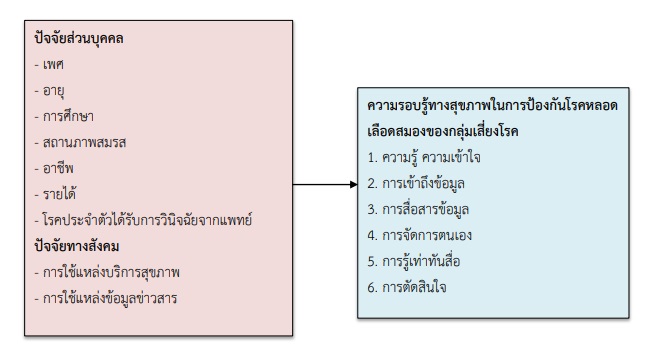ความสัมพันธ์ระหว่างปัจจัยส่วนบุคคลและปัจจัยทางสังคมกับความรอบรู้ด้านสุขภาพในการป้องกันโรคหลอดเลือดสมองของกลุ่มเสี่ยงโรคหลอดเลือดสมองอายุ 35 ปีขึ้นไปในจังหวัดนนทบุรี
คำสำคัญ:
กลุ่มเสี่ยงโรคหลอดเลือดสมอง, ความรอบรู้ทางสุขภาพ, การป้องกันโรคหลอดเลือดสมองบทคัดย่อ
การวิจัยเชิงสหสัมพันธ์เพื่อศึกษาความสัมพันธ์ระหว่างปัจจัยส่วนบุคคล ปัจจัยทางสังคมกับความรอบรู้ด้านสุขภาพในการป้องกันโรคหลอดเลือดสมองของกลุ่มเสี่ยงโรคหลอดเลือดสมองอายุ 35 ปีขึ้นไปในจังหวัดนนทบุรี กลุ่มตัวอย่างคือ กลุ่มเสี่ยงโรคหลอดเลือดสมองอายุ 35 ปีขึ้นไป จำนวน 209 คน โดยการสุ่มตัวอย่างแบบหลายขั้นตอน เครื่องมือวิจัย เป็นแบบสอบถาม ได้แก่ 1) ปัจจัยส่วนบุคคล 7 ข้อ 2) ปัจจัยทางด้านสังคม 2 ข้อ 3) ความรอบรู้ด้านสุขภาพ จำนวน 42 ข้อ ตามแนวคิดของกองสุขศึกษา มีค่าความเชื่อมั่นเท่ากับ 0.85 และค่า KR-20 เท่ากับ 0.79 สถิติที่ใช้ ได้แก่ ความถี่ ร้อยละ ค่าเฉลี่ยและวิเคราะห์ความสัมพันธ์ด้วยสถิติ Eta Coefficient Pearson’s Correlation Coefficient และ Spearman’s Correlation Coefficient ผลการวิจัยพบว่า
1. คะแนนเฉลี่ยความรอบรู้ด้านสุขภาพทางสุขภาพในการป้องกันโรคหลอดเลือดสมองโดยรวมอยู่ในระดับปานกลาง
2. ความสัมพันธ์ระหว่างปัจจัยส่วนบุคคลกับความรอบรู้ด้านสุขภาพพบว่ามีความสัมพันธ์กับสถานภาพสมรส (η=.102, p<.001) ระดับการศึกษา (ρ=.285, p<.001) อาชีพ (η=.087, p=.002) รายได้ (r=.144, p=.037) 3) ความสัมพันธ์ระหว่างปัจจัยทางสังคมกับความรอบรู้ด้านสุขภาพพบว่า มีความสัมพันธ์กับร้านขายยา (η=.019, p=.047) โรงพยาบาลรัฐ (η=.079, p<.001) โรงพยาบาลเอกชน (η=.024, p=.027) คลินิก (η=019, p=.048) และ4) ปัจจัยแหล่งข้อมูลข่าวสารเกี่ยวกับสุขภาพ พบว่ามีความสัมพันธ์กับบุคลากรทางสุขภาพ (η=.105, p<.001) อสม. (η=.026, p=.020) เพื่อน/เพื่อนบ้าน (η=.028, p=.015) สมาชิกในครอบครัว (η=.039, p=.004) อย่างมีนัยสำคัญทางสถิติ
นำผลวิจัยไปพัฒนาศักยภาพของบุคลากรทางสุขภาพสนับสนุนจากบุคลากรทางสุขภาพ อสม.เพื่อน/เพื่อนบ้านและครอบครัว เพื่อพัฒนาความรอบรู้ด้านสุขภาพในการป้องกันโรคหลอดเลือดสมองของกลุ่มเสี่ยงในชุมชน
เอกสารอ้างอิง
Chotchai, T., Seedaket, S., Taearak, K., Panyasong, S., & Buajun, A. (2020). Factors Related to Health Literacy in Prevention of Hypertension among Group at Risk in Samran Sub-District, Muaeng District, Khon Kaen Province. The Southern College Network Journal of Nursing and Public Health, 7(1), 45-56. (in Thai)
Ginggeaw, S., & Prasertsri, N. (2016). The Relationship Between Health Literacy and Health Behaviors among Older Adults who have Multi-Morbidity. Nursing Journal of the Ministry of Public Health, 25(3), 43-54. (in Thai)
Health Education Division, Department of Health Service Support, Ministry of Public Health. (2018). Promoting and Evaluating Health Literacy and Health Behaviors of Children and Youth (Aged 7-14 Years) and People Aged 15 and Over (Updated 2018). Nonthaburi: Health Education Division, Department of Health Service Support, Ministry of Public Health. (in Thai).
Hee Yun Lee, Jiwoo Lee, & Nam Keol Kim. (2015).Gender Differences in Health Literacy Among Korean Adults: Do Women Have a Higher Level of Health Literacy Than Men?. American Journal of Men’s Health, 9(5) 370–379.
Jindawattanawong, A., Peiysue, N., & Nintajan, P. (2018). Relationship Between Perceived Health Beliefs and Protective Behaviors of Stroke in High School Students. Journal of ramathibodi Nursing, 18, 58-69. (in Thai)
Kareesun, K., Malathum, P., & Sutti, N. (2019). Relationships among Health Literacy, Knowledge about Hypertension Control, and Health Behavior in Older Persons with Hypertension. Rama Nurse Journal, 25(3), 280-295. (in Thai)
Madican, K., Oba, N., & Supametaporn, P. (2020). Factors Related to Health Literacy in Patients with Uncontrolled Type 2 Diabetes. Journal of Nursing and Health Sciences, 14(1), 38-53. (in Thai)
Nutbeam, D. (2000). Health Literacy as a Public Health Goal: A Challenge for Contemporary Health Education and Communication Strategies Into the 21st Century. Health Promotion International, 15(3), 259-267.
Punsrigate Khongjaroen, K., & Nakaphong, N. (2018). The surveys on Strengthening Intelligence Needs and Self-Help of the Elderlies in Phayao Province. VRU Research and Development Journal Science and Technology, 13(3), 31- 40. (in Thai)
Tanak, L., Koshakri, R., & Jewpattanakul, Y. (2020). Factors Related to Health Literacy Among High-RiskHypertension Population in Bangkok. Journal of The Royal Thai Army Nurses, 21(3), 140-150. (in Thai)
Tantranont, K., Wisutthananon, A., Suthakorn, W., Supavititpatana, B., Lirtmunlikaporn, S., & Kampoun, S. (2020). Factors Associated with Health Literacy among Working Population, NongPa Krang Subdistrict, Mueang District, Chiang Mai Province. Lanna Public Health Journal, 16(2), 61-71. (in Thai)
Thai Health Stat. (2022). Statistics of Cerebrovascular Disease in Nonthaburi Province. Retrieved November 1, 2022 from https://www.hiso.or.th/thaihealthstat/ area/index.php?ma=3&pf=01128101&tm=2&tp=12_3&type=2
Thummaphol, P., Piaseu, N., & Arupat Maruo, S. (2016). Health Literacy and Clinical Outcomes in People with Hypertension, Dyslipidemia and Type 2 Diabetes Mellitus. Journal of Nursing and Health Care, 34(3), 176-182. (in Thai)
Trainattawan, W., Wirojratana, V., & Watanakukrilert, D. (2019). Factors Influencing Health Literacy among Older Adults. Journal of Health Science Research, 13(2), 41-51. (in Thai)
Wannapakae, J., & Phatisena, T. (2018). Relationship Between Health Literacy and Personal Factors with Health Behavior among Risk Group with Hypertension in Talad Sub-District, Muang District, Nakhon Ratchasima Province. SMT Journal, 4(Special), 176-185. (in Thai)

ดาวน์โหลด
เผยแพร่แล้ว
ฉบับ
ประเภทบทความ
สัญญาอนุญาต
ลิขสิทธิ์ (c) 2023 วารสารการพยาบาลและการศึกษา

อนุญาตภายใต้เงื่อนไข Creative Commons Attribution-NonCommercial-NoDerivatives 4.0 International License.





